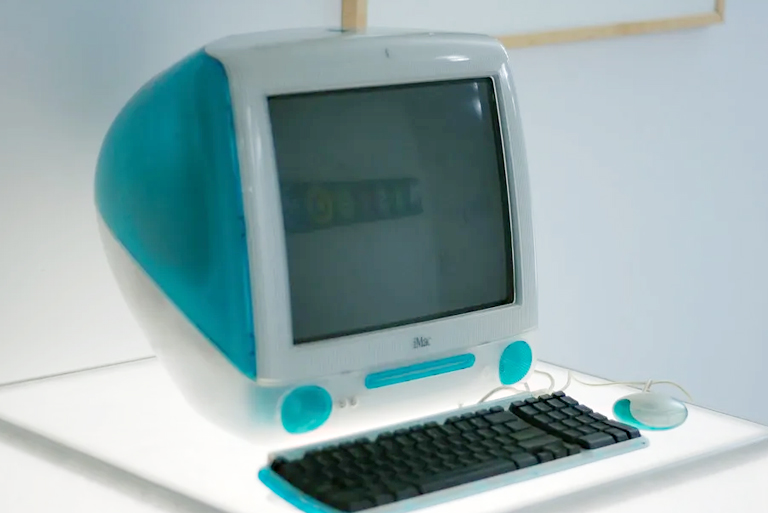Since its founding in 1976, Apple has inspired legions of devoted fans who eagerly await new products from the company, celebrating its innovative spirit. But few of these super-fans can compete with Jacek Lupina, a 56-year-old Polish architect who has eschewed savings or a pension to build a massive Apple collection.
Now, the Agence France-Presse (AFP) reports that this enormous cache is on view in Warsaw, Poland. The former 19th-century factory, Fabryka Norblina, now houses what Lupina claims is “the biggest and most complete Apple collection in the world.”

Lupina’s Apple journey began as a hobby but quickly grew into a profound passion. It consumed his home to such an extent that he had to sell most of his living room furniture to make room for his ever-expanding collection. As his domicile became unlivable, he decided to turn his house into a museum in 2017. However, it wasn’t long before the sheer volume of his Apple artifacts outgrew his home, leading to the establishment of the Apple Museum Poland, which officially opened its doors in late May.
The Apple Museum Poland boasts an astonishing collection of over 1,600 items that span the history of Apple and its associated companies. Visitors to the museum can explore these artifacts across its 3,700-square-foot space, creating a dynamic and engaging experience.
The collection includes iconic computers and devices, not only from Apple but also from NeXT, a software company founded by Steve Jobs during a brief hiatus from Apple. The diverse range of items in the collection ensures that visitors get a comprehensive understanding of Apple’s evolution and its profound impact on the world of technology.
One of the standout pieces in Lupina’s collection is a replica of the 1976 Apple I computer, which marked the inception of Apple’s remarkable journey. Only 200 original Apple I computers were ever produced, and just a handful remain in existence today. These vintage computers have recently fetched astonishing prices at auctions, some selling for as much as $500,000. Lupina’s Apple I is not an original but a meticulously crafted near-exact copy, painstakingly assembled using period-appropriate parts. Despite its wooden exterior and retro design, it serves as a testament to the ingenuity of Apple’s earliest innovations.
In addition to its vast collection of hardware, the Apple Museum Poland also boasts a rich display of advertising posters from various Apple campaigns. Among these, the 1997 “Think Different” posters featuring luminaries like Albert Einstein and Pablo Picasso are notable. Apple has not only been a pioneer in technology but also a leader in advertising, advocating a marketing model rooted in simplicity and intuitive design. These iconic posters serve as a testament to Apple’s ability to resonate with its audience on a deeper level.
Throughout its history, Apple has excelled at building upon existing technology, creating products that are sleeker, more innovative, and more user-friendly than their competitors. From the groundbreaking Apple Macintosh computer in 1984 to the game-changing iPhone in 2007, Apple’s products have consistently transformed the tech landscape.
The Apple Museum Poland is not the first institution to recognize the significance of Apple’s legacy. The Smithsonian’s National Museum of American History holds several Apple products in its collection, including one of the elusive Apple I computers. Additionally, All About Apple, a museum in Savona, Italy, boasts a vast collection of around 10,000 Apple-related items. These museums, like Lupina’s collection, stand as tributes to the enduring impact of Apple on the world of technology and design.

Jacek Lupina’s dedication to preserving the history of Apple and its impact on technology is nothing short of remarkable. His collection, now on display for the public to enjoy, is a journey through time, showcasing the evolution of Apple’s iconic products and the profound impact they have had on our lives. The museum provides a unique opportunity for tech enthusiasts, history buffs, and the curious to immerse themselves in the world of Apple, gaining insights into the company’s past, present, and future.
Beyond being a mere collection of gadgets, Lupina’s Apple Museum Poland represents a tribute to innovation, design, and the enduring legacy of a company that has consistently pushed the boundaries of technology. It invites visitors to reflect on how Apple’s products have not only shaped our digital lives but have also become cultural icons that define an era.
The significance of the Apple Museum Poland extends beyond its physical location. It serves as a testament to the power of passion and dedication in preserving and celebrating technological heritage. Jacek Lupina’s remarkable journey from a hobbyist collector to the curator of the world’s largest Apple collection is a testament to the enduring allure of Apple and its products.
In conclusion, the Apple Museum Poland stands as a unique destination for anyone interested in the history of technology and design. It offers visitors a chance to explore the evolution of Apple’s products, from the humble beginnings of the Apple I to the groundbreaking innovations of today. Jacek Lupina’s dedication to his Apple collection has created a cultural gem in the heart of Warsaw, inviting people from around the world to immerse themselves in the world of Apple and reflect on the profound impact of technology on our lives.

